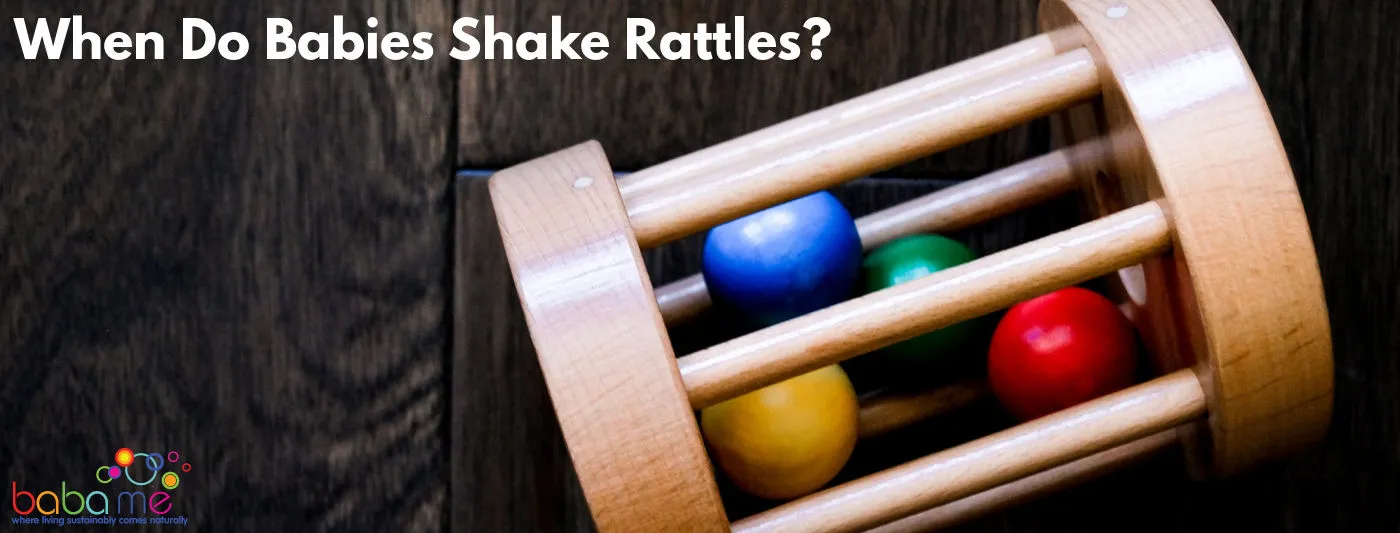Wooden baby rattles are some of the most popular baby toys. They are specifically made to amuse a newborn child and they have served this purpose since ancient times.
There is a long history of rattles, archaeologists uncovered a baby rattle made out of clay in Poland which is believed to have come from the early Lusatian culture of the Iron Age. It is also believed that the Greco-Romans use baby rattles to entertain babies based on recovered artefacts from several archaeological sites.

Rattles are more than just toys
Rattles are more than just toys. Many child experts suggest that playing with baby rattles helps an infant’s early development, particularly hand-eye coordination.
When you hold a rattle and shake it to make a sound, your baby will look at the rattle with her eyes. If you shake the rattle, most likely your baby will follow the movement from which she will learn visual tracking to watch a moving object.
You can buy a baby rattle even if your child has not yet developed the ability to grasp things. You can use it to get her attention when she’s fuzzy or during feeding time. Auditory stimulation is important and the sounds a rattle makes are great for stimulating your child’s sense of hearing.
When is the right time to introduce a baby rattle?
The perfect time to introduce a baby rattle to your child is when she’s starting to take a swipe off of toys or when she already knows how to grasp or hold.
This developmental milestone normally happens at age 3-4 months but could be later for other newborns. Around the same age, your baby learns how to reach for an object with her fingers.
You can also use the rattle during tummy time. Tummy time is one of the first exercises and is essential to a child’s physical development.
Once he starts learning how to use his legs and arms to crawl, you can shake the rattle and allow your child to find the rattle. Another good thing to do during tummy time is to hold and shake the rattle and describe to your baby the sound it makes.
If money is not an issue, you can buy different kinds of rattles. You can buy a plastic rattle, wooden rattle and a cloth rattle. Each of these rattles have different textures which makes them great for tactile stimulation.
Initially, your baby will just hold on to the rattle. As she develops her fine motor skills and hand-eye coordination, she will start shaking the rattle on her own.
Most babies are prone to putting objects into their mouths so make sure that the rattle is in good condition and no detachable parts that could be potential hazards when letting your baby play with a rattle.
Most babies explore with their hands and mouth so you do not want any loose parts from your rattle to end up in your baby’s mouth. Some rattles have soft surfaces that can double as a teether.

FAQs about when babies start shaking rattles
When do babies start shaking rattles?
Babies typically start shaking rattles between the ages of 3 and 6 months, when they begin to develop their motor skills and coordination.
Why is shaking a rattle an important developmental milestone?
Shaking a rattle is an important developmental milestone because it helps babies learn about cause and effect, spatial awareness, and the relationship between their movements and the sounds they produce.
What are some signs that a baby is ready to start shaking rattles?
Some signs that a baby is ready to start shaking rattles include reaching and grasping for objects, exploring objects with their hands and mouth, and showing interest in sounds and movements.
What types of rattles are best for babies to shake?
Rattles that are lightweight, easy to grasp, and have a variety of textures and sounds are ideal for babies to shake. Other toys, for example soft, fabric or silicone rattles are also a good option for younger babies who are still developing their motor skills.
How can parents and caregivers support and encourage their baby to start shaking rattles?
Parents and caregivers can support and encourage their baby to start shaking rattles by providing a variety of safe and age-appropriate toys, placing rattles within reach, modeling how to shake a rattle, and providing positive reinforcement and encouragement, remember to clean babies rattles often.
Are there any safety considerations to keep in mind when giving babies rattles to shake?
Yes, it’s important to ensure that rattles are age-appropriate and free of small parts or other choking hazards. Parents and caregivers should also regularly inspect rattles for any signs of wear or damage and discard them if they become damaged or broken.

What other types of toys can help promote a baby’s motor skills and coordination?
Other toys that can help promote a baby’s motor skills and coordination include activity gyms with dangling toys, play mats, stacking toys, and toys with buttons or switches that babies can press or manipulate.
Tummy time is also an important activity for promoting motor development in babies, and you;ll find baby’s hands reaching out to grab their favorite toy or teddy bear.
It’s important to introduce toys in line with baby’s development. For example, when your baby has reached developmental milestones such as staying independently in a sitting position or passing small objects from one hand to the other, you’ll find that baby’s motor skills will progress at an amazing rate.
At around 6 months your baby will be able to bring soft finger foods to their mouths, many babies love to mouth and so even if they aren’t eating much, this is fantastic practice in coordination and fine motor skills.




